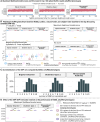Network medicine-based epistasis detection in complex diseases: ready for quantum computing
- PMID: 39175109
- PMCID: PMC11417373
- DOI: 10.1093/nar/gkae697
Network medicine-based epistasis detection in complex diseases: ready for quantum computing
Abstract
Most heritable diseases are polygenic. To comprehend the underlying genetic architecture, it is crucial to discover the clinically relevant epistatic interactions (EIs) between genomic single nucleotide polymorphisms (SNPs) (1-3). Existing statistical computational methods for EI detection are mostly limited to pairs of SNPs due to the combinatorial explosion of higher-order EIs. With NeEDL (network-based epistasis detection via local search), we leverage network medicine to inform the selection of EIs that are an order of magnitude more statistically significant compared to existing tools and consist, on average, of five SNPs. We further show that this computationally demanding task can be substantially accelerated once quantum computing hardware becomes available. We apply NeEDL to eight different diseases and discover genes (affected by EIs of SNPs) that are partly known to affect the disease, additionally, these results are reproducible across independent cohorts. EIs for these eight diseases can be interactively explored in the Epistasis Disease Atlas (https://epistasis-disease-atlas.com). In summary, NeEDL demonstrates the potential of seamlessly integrated quantum computing techniques to accelerate biomedical research. Our network medicine approach detects higher-order EIs with unprecedented statistical and biological evidence, yielding unique insights into polygenic diseases and providing a basis for the development of improved risk scores and combination therapies.
© The Author(s) 2024. Published by Oxford University Press on behalf of Nucleic Acids Research.
Figures






Update of
-
Network medicine-based epistasis detection in complex diseases: ready for quantum computing.medRxiv [Preprint]. 2023 Nov 9:2023.11.07.23298205. doi: 10.1101/2023.11.07.23298205. medRxiv. 2023. Update in: Nucleic Acids Res. 2024 Sep 23;52(17):10144-10160. doi: 10.1093/nar/gkae697. PMID: 38076997 Free PMC article. Updated. Preprint.
References
MeSH terms
Grants and funding
- TUM
- Munich Quantum Valley
- 777111/Horizon 2020
- 422216132/Deutsche Forschungsgemeinschaft
- European Union's Horizon 2020
- WT_/Wellcome Trust/United Kingdom
- DK/NIDDK NIH HHS/United States
- Bavarian State Ministry of Science and the Arts
- *ZX1908A/01ZX2208A*/Federal Ministry of Education and Research
- German Excellence Initiative
- EU Smart Growth Operational Programme
- CERN Quantum Technology Initiative
- 2018/MAB/5/Foundation for Polish Science
- 813533/Marie Sklodowska-Curie
LinkOut - more resources
Full Text Sources

